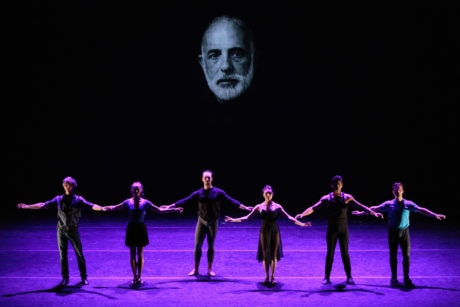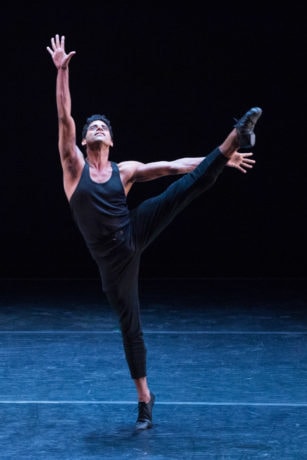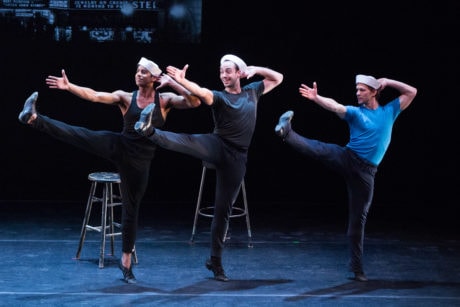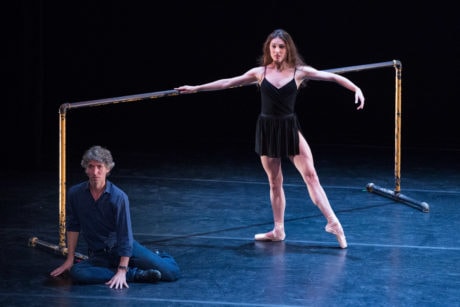No curtain opened on the black and white picture of Jerome Robbins, smiling, in a sweatshirt, a hand on his forehead and another on the chest of one of his two dogs. There was no boundary unrolled, no delineation of performance. Though warm, this image of the renowned choreographer, projected as a backdrop, still presided over the stage below. Then principal dancers from New York City Ballet filtered in for a typically private ritual: warm-up at the barre. Swish, rond de jambe, swish, swish—ball of the foot—smile, hey there—flick —pop, ooh—you’re dancing later—me too—pull, twist, calf stretch.

There were Tyler Angle and Amar Ramasar doing pliés, side by side. Tiler Peck walked on in leg warmers. Daniel Ulbricht joined and appeared to run some choreo behind them (for effect, I imagine, as he performed each of his variations with technical perfection). The artistic emcee of the evening, former NYCB principal, now choreographer, and producer, Damian Woetzel, sauntered in and was absorbed as part of the family. He mingled with the cast, grinned, turned around and waved to someone in the audience. For any dance enthusiast, these were intimate moments to witness. Behind-the-scenes was center stage, for a glimpse.
But such is the goal of this iteration of Woetzel’s DEMO series, which in this centennial year of Mr. John F. Kennedy, and in celebration of Robbins’ centennial next year, pays tribute to the legendary choreographer and the art of dance in a lecture-demonstration format, rather than a perfectly choreographed performance.

Enriched with unique perspective as Robbins’ former student (Woetzel shared the story of Robbins “discovering” him in ballet class in NYC in 1984, when he was 17) Woetzel guided the audience through some of his instructor’s life work—from ballets Fancy Free (1944), Afternoon of a Faun (1953), Moves (1959), Three Chopin Dances (1979)—to choreographic odes from classic Broadway hits West Side Story (1957), The King and I (1951), and Gypsy (1959). Woetzel provided the context, even danced sometimes himself. He and his fellow dancers then took it away, brought it home—almost into their offstage home, that is: the studio.
As the principals danced through the variations, Woetzel and occasionally his wife, special guest Heather Watts, who danced at NYCB under both Balanchine and Robbins, would narrate, correct, comment, reflect. The analysis in the in-between allowed for something never exposed on stage in the ballet world: imperfection, the editing process. As Woetzel explained in his opening, they were here to “work on the work.” So much of ballet is hiding the “work” and mastering, through repetition, the art of expertise, to achieve the look of effortlessness. Woetzel, Watts and NYCB performed the work of the work, a welcome reminder of the technique it takes to forget about technique, and truly dance well.
Ramasar, Ulbricht and Angle danced Fancy Free, Robbins’ first ballet, a musical collaboration with Leonard Bernstein which premiered at the Metropolitan Opera House in April 1944. The characters, three sailors on shore leave for a night of gallivanting in the Big Apple, were such a delight to audiences then that before too long they inspired the musical, On The Town (1944).
Angle, the “smooth” one, moved with an adagio quality. Perhaps his character is a tad too slick and sure of himself, so says the choreography. In the breakdown, Woetzel called one step “the sweep,” in which Angle, in a soft plié, legs in second position, weight toward the left side, then the right, circles his arms, then holds them aloft—a pause—in hopeful anticipation. Angle revealed, interview-style, that he imagines wheat fields in those moments. Ulbricht’s strength and agility made him an ideal match for his allegro character. His chaȋné turns into pirouettes into fouettés into fouettés with a flexed foot were seamless, flawless, the momentum so much in his favor that Woetzel had him keep going, on the spot. “It was going so well!” the mentor said, joyful. Ulbricht padded off, smiling, too. A video clip of Woetzel rehearsing the third sailor role with Robbins as a young man preceded Woetzel’s rehearsal with Ramasar on stage, (no pressure). “Sorry; we’re going to work for a second,” Woetzel told everyone. After they’d perfected an elevating chest torque, he said to Ramasar: “Tell your children.”

Tiler Peck silenced the room with each entrance. In Three Chopin Dances (1979), Other Dances (1976), and Dances at a Gathering (1969), her graceful control of port de bras reveals a nuanced tone to her dancing. She lingers in the right moments, holds through the balances. Though it seemed impossible, Watts coached her to “sustain” one developpé balance in an entrance even longer. She did, visibly. The audience oohed. Watts, earnest, said, “Jerry (Jerome Robbins) would die happy all over again,” and laughing, remarked, “You get what you ask for, right?” Peck shared that one of the pas de deux was “her favorite thing to dance ever.” The passion, the joy she experiences, radiates outward, into the house, across the aisles.
Though New York may be the company’s epicenter, home to Robbins’ legacy, Washington was also featured as a city of significance to the company. Robbins was a 1981 Kennedy Center Honoree, after all. Angle also danced one of the Three Chopin Dances Mikhail Baryshnikov performed as an NYCB principal for Mr. and Mrs. Carter at the White House in 1979.
In true diplomatic fashion, to commemorate Robbins’ The King and I, Woetzel called upon his friend in the audience, Julie Kent, the longest-serving ballerina ever at American Ballet Theater and now at the helm of The Washington Ballet as Artistic Director, to join him on stage for a dance. “Will you give this a shot with me?” he asked. In the spirit of transparency, the theme of backstage, he admitted the two had rehearsed “over text.” No one would have ever known. Dancing is innate for them, muscle memory. Kent recalled that the polka was the first dance step she learned. Woetzel nodded, laughing, “Yes, everyone learns the polka in Nutcracker auditions.” A little known dancer fact. It was so charming, this duet of dance icons. After bow and curtsy, Woetzel said, to Washington: “You are so lucky to have her,” and to Kent, “I just wish you every good thing.” An observant partner, Kent then fixed his microphone, and slid gracefully offstage. It’s what the best artists tend to do, I think—look out for one another. They are a team, a family.

Before NYCB danced Fancy Free, we heard a recording of Leonard Bernstein’s words to his fellow young friend and collaborator, Jerome Robbins. They were understatedly detailed notes on the sheet music he was sending for Robbins to use in his first ballet.
In a nice echo of that musical partnership, Kurt Crowley, music director/conductor of the Broadway hit Hamilton, was on piano for the evening, and vocalist Kate Davis, sang live accompaniment. In his message, Bernstein also made sure to send something else to Robbins and co.: “Give my love to everybody in the thing.”
DEMO celebrates Jerome Robbins, creative work, good will, good things, and the cyclical method of passing down dance to future generations. Woetzel highlighted the ability of Robbins’ choreography to translate from studio to stage. He and the dancers would say, “Something happened on the way from the fifth floor.”
Something also happened up in the Terrace Theater. A window was left open onto all stages of the process for which these dancers and choreographers continue to gather, as, Woetzel says, “one heart, one nation, and one soul, through art.”
Running Time: 80 minutes with no intermission.

DEMO by Damian Woetzel: Jerome Robbins–American Dance Genius plays Friday, October 20 and Saturday, October 21, 2017 at 7:30 p.m., at the John F. Kennedy Center for the Performing Arts – 2700 F St. NW in Washington, D.C. For tickets to Saturday’s performance, call the Box Office at (202) 467-4600 or order them online.
https://www.kennedy-center.org/video/index/A93297




